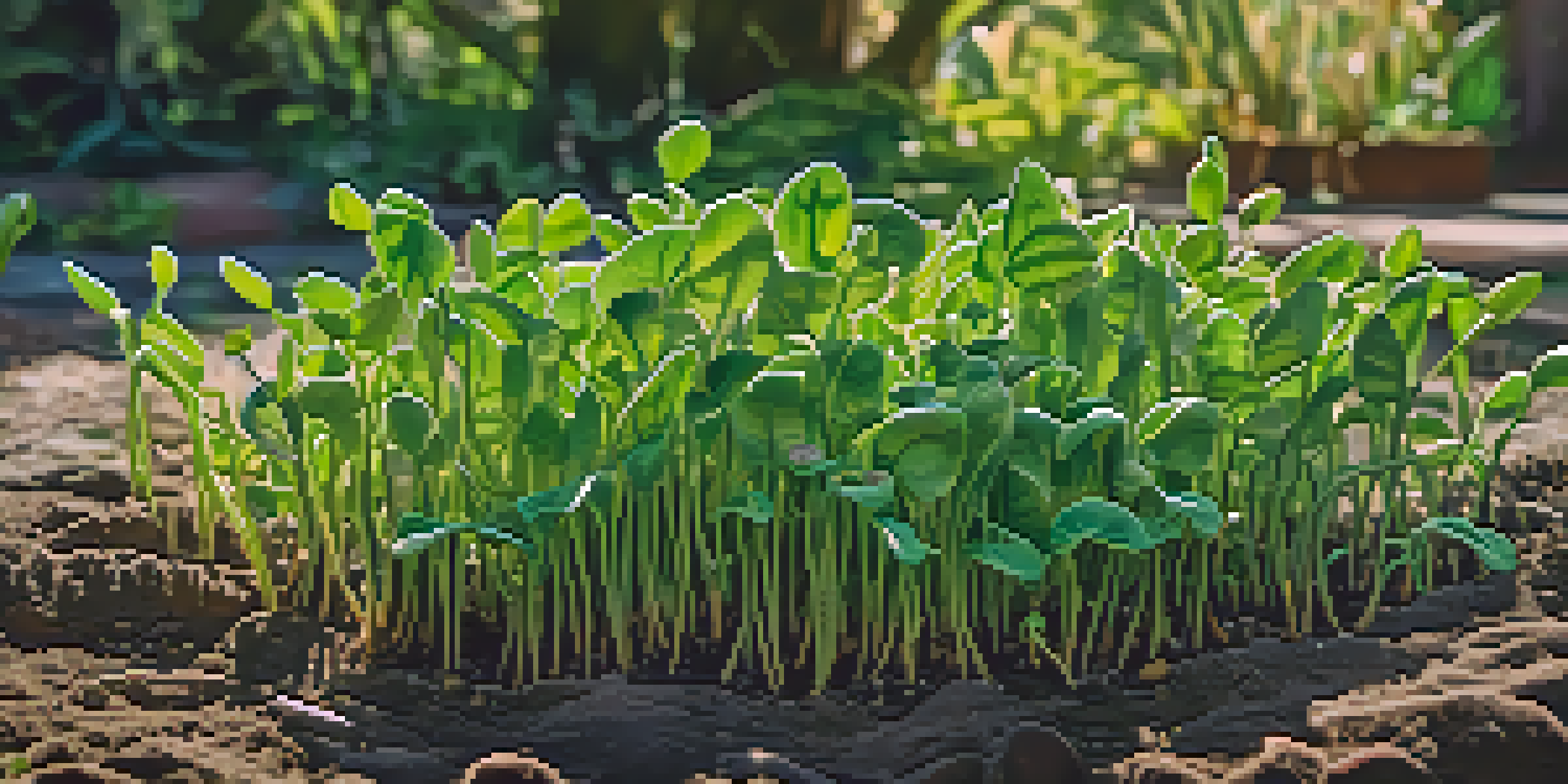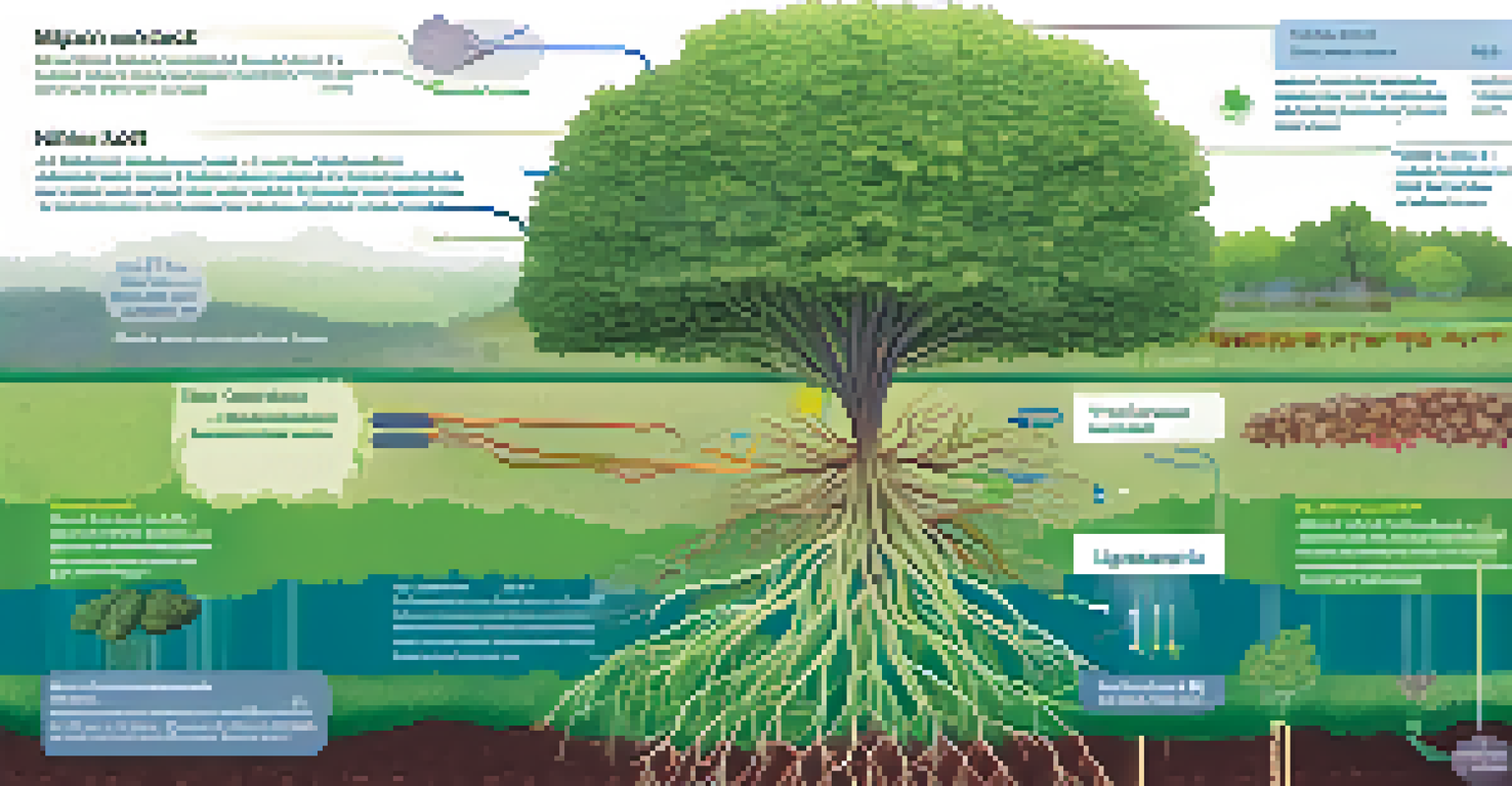The Process of Nitrogen Fixation in Plant Growth Dynamics

What is Nitrogen Fixation and Why is it Important?
Nitrogen fixation is a natural process that converts atmospheric nitrogen into a form usable by plants. This is crucial because nitrogen is a fundamental building block of proteins and nucleic acids, which are essential for plant growth. Without this process, many plants would struggle to obtain enough nitrogen, leading to poor growth and development.
The nitrogen cycle is the backbone of all life on Earth.
The importance of nitrogen fixation extends beyond individual plants; it plays a vital role in entire ecosystems. Healthy plant growth supported by nitrogen fixation can lead to improved soil quality and increased biodiversity. Essentially, it acts as a cornerstone for maintaining the balance within various ecosystems.
Understanding nitrogen fixation is particularly important for farmers and gardeners. By knowing how it works, they can implement practices that enhance this natural process, ultimately leading to more robust and productive crops. This knowledge can also inform sustainable agricultural practices, reducing the need for synthetic fertilizers.
The Mechanism of Nitrogen Fixation Explained
Nitrogen fixation primarily occurs through two main processes: biological and abiotic. Biological nitrogen fixation is carried out by certain microorganisms, such as bacteria and archaea, which possess the unique ability to convert nitrogen gas into ammonia, a form that plants can absorb. This process happens in root nodules of legumes or free-living bacteria in the soil.

On the other hand, abiotic nitrogen fixation can occur through natural events like lightning or human-made processes, such as industrial fertilizer production. While these methods do add nitrogen to the soil, the biological process remains the most efficient and environmentally friendly way to enrich soil nitrogen levels for plant use.
Nitrogen Fixation Supports Plant Growth
Nitrogen fixation is essential for converting atmospheric nitrogen into a usable form for plants, promoting healthy growth and development.
Both processes contribute significantly to the nitrogen content in the soil. However, biological fixation is preferred in sustainable farming as it fosters a natural balance and reduces dependence on chemical fertilizers. This balance is key to ensuring long-term soil health and fertility.
The Role of Symbiotic Relationships in Nitrogen Fixation
Many plants, particularly legumes, form symbiotic relationships with nitrogen-fixing bacteria like Rhizobium. In this partnership, the bacteria live in the plant's root nodules and convert atmospheric nitrogen into ammonia, while the plant provides carbohydrates and a protective environment for the bacteria. This mutualistic relationship is a prime example of nature's cooperation.
Healthy soils are the foundation of sustainable agriculture, and nitrogen fixation is a key component of that health.
These symbiotic interactions not only enhance nitrogen availability but also promote healthier plant growth. Plants with these relationships often exhibit increased resilience against pests and diseases, leading to better yields. This is particularly beneficial for farmers looking to maximize their crop output in a sustainable manner.
Moreover, these relationships can improve soil structure and fertility over time, benefiting subsequent crops in rotation. Thus, planting legumes can serve as a natural way to enhance soil nitrogen levels, reducing the need for synthetic fertilizers and promoting a more sustainable agricultural system.
Factors Affecting Nitrogen Fixation in Plants
The efficiency of nitrogen fixation can be influenced by several environmental factors, including soil moisture, temperature, and pH levels. For instance, excessively dry or waterlogged soils can hinder the activity of nitrogen-fixing bacteria, reducing their effectiveness. Similarly, extreme temperatures can also adversely affect these microorganisms.
Soil pH plays a crucial role as well; most nitrogen-fixing bacteria thrive in slightly acidic to neutral conditions. If the soil becomes too alkaline or too acidic, it can limit bacterial activity and, consequently, the nitrogen fixation process. Therefore, maintaining optimal soil conditions is vital for supporting this essential function.
Symbiotic Relationships Enhance Yield
Legumes that form partnerships with nitrogen-fixing bacteria show improved resilience and yield, benefiting sustainable agricultural practices.
Additionally, nutrient availability, particularly phosphorus and potassium, can impact the efficiency of nitrogen fixation. A balanced nutrient profile helps ensure that both plants and their microbial partners can thrive, thus enhancing the overall process of nitrogen fixation. Farmers must regularly test soil and adjust nutrient levels to optimize plant growth.
The Impact of Nitrogen Fixation on Crop Yield
Nitrogen fixation has a direct correlation with crop yield and quality. Crops that benefit from nitrogen-fixing bacteria typically exhibit more vigorous growth, leading to higher yields. This is particularly evident in legumes, which can significantly enhance soil nitrogen levels and support neighboring crops in a rotation system.
Moreover, plants that access adequate nitrogen through fixation tend to produce more robust fruits and seeds, ultimately improving the quality of the harvest. This can translate into better market prices and improved food security for farmers and communities alike.
In fact, integrating nitrogen-fixing crops into agricultural systems can reduce the need for chemical fertilizers, lowering costs for farmers and minimizing environmental impact. This practice not only boosts crop yields but also fosters a sustainable approach to farming that benefits both the economy and the ecosystem.
Sustainable Practices to Enhance Nitrogen Fixation
To enhance nitrogen fixation, farmers can employ several sustainable practices. Crop rotation, especially with legumes, allows for natural replenishment of soil nitrogen and promotes biodiversity. By alternating crops, farmers can maintain soil health and reduce the risk of pests and diseases that often accompany monoculture farming.
Another effective practice is cover cropping, where farmers plant specific crops during off-seasons to protect and enrich the soil. These cover crops can fix nitrogen and improve soil structure, leading to better water retention and nutrient availability. This not only supports nitrogen fixation but also contributes to overall ecosystem health.
Factors Influence Nitrogen Fixation
Environmental conditions such as soil moisture, temperature, and pH levels significantly affect the efficiency of nitrogen fixation in plants.
Additionally, minimizing tillage can help protect the soil structure and the beneficial microorganisms within it. Reduced disturbance allows nitrogen-fixing bacteria to thrive, ensuring that the soil remains fertile. By adopting these practices, farmers can create a more resilient agricultural system that supports both productivity and environmental sustainability.
Future Directions in Nitrogen Fixation Research
Research into nitrogen fixation continues to evolve, with scientists exploring innovative ways to optimize this process. Advances in biotechnology aim to enhance the efficiency of nitrogen-fixing bacteria, potentially allowing non-leguminous crops to benefit from these relationships. This could revolutionize how we approach crop production and sustainability.
Scientists are also investigating the role of soil microbiomes in nitrogen fixation, seeking to understand how diverse microbial communities interact with plants. This research could lead to new methods for enhancing soil health and optimizing nutrient delivery to plants, ultimately improving crop yields.

Moreover, understanding the impact of climate change on nitrogen fixation is crucial. Researchers are studying how changing temperatures and precipitation patterns affect microbial activity and plant interactions, which will inform future agricultural practices. By staying ahead of these challenges, we can ensure the sustainable productivity of our food systems.